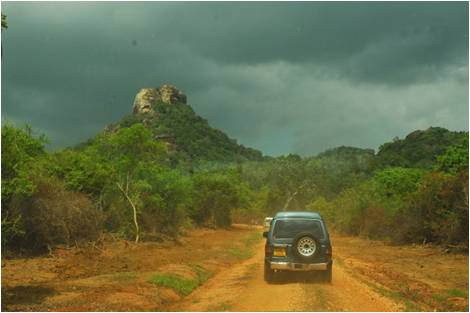EPISODE 14 – Lunugamvehera National Park

The Narrow Escape
I joined the Department of Wildlife Conservation in 1999. After working in Horton Plains for a short period I was transferred to Lunugamvehera National Park on duty in the year 2002. At that time, I did not have much experience in official duties.
Lunugamvehera is situated Adjacent to the Yala National Park and on the other side is the Udawalawe National Park. There are many elephants in both these parks. That is why elephants are often seen in the Lunugamvehera National Park.
As the Wildlife Officers our role is to help the animals meet their food, water and salt needs. We worked to meet the salt needs of these elephants. Pits were dug and salt was brought from the Hambantotasaltern and filled to make salt deposits. This one hole is usually 4 feet x 4 feet 4 x 4 feet. It should be monitored to see if Elephants can benefit from salt deposits. We always vigilant on that.
One day I was traveling with our group on a patrol in Bolhindagala area. Lunugamvehera National Park is accessed also from the site of the Thanamalwila Black Bridge. On my way back to the office after patrolling that day, I wanted to see some salt deposits nearby. I asked to stop the vehicle and went down to the salt deposits.
This salt deposit was located about 20 feet [20 m] from where I was staying. First there is an area like a lawn with occasional trees. Next is the salt deposit. And then the jungle starts.
I checked to see if the salt had eaten by the animals. There was elephant dung. It was obvious that the elephants had used salt deposits. I was closely observing the salt deposits.
Suddenly I heard a noise and I saw a big elephant behind me. I looked that way because of its sound. The distance between the two of us is about 5 feet. I couldn’t utter a word even due to fear of death. The next moment I turned around and ran as fast as a robot. My legs felt amazing strength; I ran fast towards the place where the vehicle was parked. I felt the elephant coming closer and closer behind me.
Our team opened the door of the vehicle and shouted at the elephant. At that sound the elephant’s harshness subsided. I was able to get in the car. At the same time we drove the vehicle fast.
That day I learned that when going to the forest, one should go with a good understanding of animals. That incident was the best experience in my life.
I still remember that fear of life.
Mr. R. P. S. Uduporuwa

Mr. R. P. S. Uduporuwa joined the Department of Wildlife Conservation on01stJune, 1999 as a Wildlife Ranger.
During his 22 years of service, he has worked in the Horton Plains and Wilpattu National Parks, Muthurajawela, Victoria, Randenigala, Rantambe Sanctuaries and is currently the Park Warden of Angammedilla National Park.
Mr. Uduporuwa has completed the Diploma in Wildlife Management offered by the Department of Wildlife Conservation for site guards.
Mr. Uduporuwa’s loving wife is a teacher and they live in Mawanella area.
Lunugamvehera National Park
According to the provincial nomenclature of our country,Lunugamvehera National Park, a precious forest area, which is located in the Uva Province is unique for its biodiversity. It extends Thanamalwila, Wellawaya, Kataragama and Buttala Divisional Secretariats in the Moneragala District and Lunugamvehera in the Hambantota Divisional Secretariat. This National Park is an important habitat for birds and elephants. Also functioning as a corridor for migrating elephants from Yala to Udawalawe National Park, it was established on 08th December 1995 as the Lunugamvehera National Park with an area of 23,498 hectares for the protection of wild elephants.
Lunugamvehera National Park is located 261 km southwest of Colombo whilst located in the dry zone of Sri Lanka and is a park exposed to the annual drought. The elevation of the park is 91 meters (299 feet).Lunugamvehera Reservoir occupies a significant area of the park, covering 14 percent of the total land area, or 3283 hectares. The average annual temperature of Lunugamvehera is 30 C (86 F) and thus the total dry area of the park is 20,156.8 hectares. It is abundant of soft, wrinkle-free, plains and rocky outcrops, this arid zone garden is prone to annual droughts.
The significance of history is evident with the presence of the NilgiriDagoba and the remains of a ruined temple. Also nearby is the MagulMahaVihara which is considered to be the place where Goddess Viharamaha got married. You can still see the ruins of a magulporuwa built inside the temple and the only moon stone ever found in Asia with four mahouts.
Lunugamvehera National Park consists of several layers of forest. These forests are made up of bushes and grasslands. Teak and eucalyptus plantations are now abundant in the forest. Lunugamvehera National Park consists of several layers of forest. These forests are made up of bushes and grasslands. Teak and eucalyptus plantations are now abundant in the forest. The park is a dry mixed evergreen forest mainly with Weera (Drypetes sepiaria), Palu (Manilkara hexandra), Kunumella (Diospyros ovalifolia), Ul kenda (Polyalthia korinti), Kappetiya (Croton lacciferus), Kon (Schleichera oleosa) as well as plantations including Teak (Tectona grandis) and Eucalyptus species. Large grasslands and grasses such as Mayaurathana (Chloris montana), Illuk (Imperata cylindrical), guinea grass (Panicum maximum), Hinthambala (Carmona microphylla), and shrubs while this diversity of flora and fauna in the National Park provides food, shade and shelter for the animals that live here.
The area is home to a wide range of fauna, from small ants to large land elephants. It is home to 21 species of fish, 12 species of amphibians, 33 species of reptiles, 183 species of birds and 43 species of mammals. The park is rich in biodiversity whilst it is home for Asian elephant (Elephas maximus), Water buffalo (Bubalus bubalis) Wild Boar (Sus scrofa), Common Mongoose (Herpestes edwardsi), Giant squirrel (Ratufa macroura), Sloth bear (Ursus ursinus), Common agamid Lizard (Calotes versicolor), Red lipped lizard (Calotes ceylonensis), Star tortoise (Testudo elegans), Python (Python molurus). It is a favorable habitat for a large number of animals. Elephants are often seen roaming in the Lahugala electorate due to the presence of Beru grass, one of their favorite foods. This area is also known as the Elephant Food Store.


Lunugamvehera Reservoir and thousands of other water bodies in the park are home to water birds. It has become a breeding ground for nearly 200 endemic and migratory species. Bird species found here include the Jungle fowl (Gallus lafayettii), Sri Lanka Woodshrike (Tephrodornis affinis), Blue faced malkoha (Phaenicophaeus viridirostis), Sri Lanka Brown capped Babbler (Pellorneum fuscocapillus), Spot-Billed Sri Lanka (Pelecanus philippensis) as well as the gray hornbill (Ocyceros gingalensis). Lunugamvehera National Park is home to a wide variety of birds in Sri Lanka and is ideal for bird watching.


The two main access roads to the park headquarters are from Colombo to Ratnapura via Udawalawe, Thanamalwila to Lunugamvehera at approximately 231km and from Colombo to Hambantota via Tissamaharama, Thanamalwila to Lunugamvehera at approximately 265km. Lunugamvehera is located in the Moneragala District of the Uva Province, 261 km from Colombo and can be accessed via Tissamaharama in the Southern Province or via Kalawana in the Sabaragamuwa Province.
As a dry zone forest, the park has two entrances to visit throughout the year, as it records a temperature of close to 30 degrees Celsius with rainfall between November and January each year. Lunugamvehera is a National Park with less tourists so you can enter the park peacefully to enjoy the wildlife.One entrance is located near Thanamalwila on the Hambantota – Wellawaya road and the other entrance is on the SellaKataragama – Buttala road towards Galge. Many people prefer the nearby Yala National Park to the Lunugamvehera National Park, although there is very little traffic at the entrance. Although there is very little traffic at the entrance to Lunugamvehera National Park, this national park is also an area worth visiting and this national park is also an ideal place to visit wildlife.

Sources
National Parks of Sri Lanka (P.M Senaratne)
Forest, Parks and Forest Conservation Laws of Sri Lanka (PeirisRanasinghe) Wildlife tour Sri Lanka
Wikipedia
Ecoteam
Reddottours
List of animals in the Lunugamvehera National Park
Sinhala Name | Tamil Name | English Name | Scientific name |
අලියා | ஆசிய யானை | Asian elephant | Elephas maximus |
දිවියා | சிறுத்தை | Leopard | Panthera pardus kotiya |
වලහා | தேன் கரடி | Sloth bear | Ursus ursinus |
වල් ඌරා | காட்டுப் பன்றி | Wild Boar | Sus scrofa |
තිත් මුවා | புள்ளி மான் | Spotted deer | Axis axis ceylonensis |
මී හරකා | எருமை | Water buffalo | Bubalus bubalis |
මුගටියා | இந்திய சாம்பல் கீரிப்பிள்ளை | Common Mongoose | Herpestes edwardsi |
දඬු ලේනා | பழுப்பு மலை அணில் | Giant squirrel | Ratufa macroura |
ගරා කටුස්සා | பொதுவான தோட்டப்பல்லி | Common agamid Lizard | Calotes versicolor |
තොල විසිතුරු කටුස්සා | சிவப்பு உதட்டுப் பல்லி | Red lipped lizard | Calotes ceylonensis |
| තාරකා ඉබ්බන් | நட்சத்திர ஆமைகள் | Star tortoise | Testudo elegans |
පිඹුරා | மலைப்பாம்பு | Python | Python molurus |
වලි කුකුළා | இலங்கைக் காட்டுக் கோழி | Sri lankajunglefowl | Gallus lafayettii |
වන සැරටිත්තා | சிலோன் வுட்ஷ்ரைக் | Sri Lanka Woodshrike | Tephrodornis affinis |
ලංකා දුඹුරු දෙමලිච්චා | பழுப்பு நிற மூடிய புழுணி | Sri Lanka Brown capped Babbler | Pellorneum fuscocapillus |
| අළු කෑදැත්තා | இலங்கை சாம்பல் இருவாய்ச்சி | Sri lanka Grey Hornbill | Ocyceros gingalensis |
වත නිල් මල් කොහා | நீல முகச் செண்பகம் | Blue – faced malkoha | Phaenicophaeus viridirostis |
පැස්තුඩුවන් | சாம்பல் கூழைக்கடா | Spot-Billed pelican | Pelecanus philippensis |
පොරෝ කෑදැත්තා | மலபார் கறுப்பு வெள்ளை இருவாய்ச்சி | Malabar pied horn bill | Anthracoceros coronatus |
රෑන කාවා | இந்திய நெடுங்கிளாத்தி | Indian darter | Anhinga melanogaster |
List of trees in the Lunugamvehera National Park
Sinhala Names | Tamil Names | English Names | Botanical Name |
පලු | பாலை | Palu | Manilkara hexandra |
වීර | வீரை | Hedge Box wood | Drypetes sepiaria |
කුණුමැල්ල | கரிமரம் | Kunumella | Diospyros ovalifolia |
උල්කෙන්ද | உழுவிந்தை | Ulkenda | Polyalthia korinti |
කැප්පෙට්ටියා | தெப்பாடி | Kappetiya | Croton lacciferus |
කෝන් | பூக்கம் | Kon | Schleichera oleosa |
තේක්ක | தேக்கு | Teak | Tectona grandis |
| යුකැලිප්ටස් | யூக்கலிப்டஸ் | Eucalyptus species | |
මයුරතණ | மயுரபுல் | Mayaurathana | Chloris montana |
| ඉලුක් | இலுக் | Illuk | Imperata cylindrical |
ගිණියාතණ | கினியாபுல் | Guinea tana | Panicum maximum |
හීන්තඹල | குரங்குவெற்றிலை | Hinthambala | Carmona microphylla |
Editor- Dammika Malsinghe, Additional Secretary,Ministry of Wildlife and Forest Conservation (MWFC)
Article on park written by- Hasini Sarathchandra, Chief Media Officer, Department of Wildlife Coservation (DWLC)
Mahesha Chathurani Perera (Graduate Trainee), (DWLC)
Tamil Translations- A.R.F. Rifna, Development Officer, MWFC
English Translations – Asoka Palihawadana, Translator, MWFC
Web Designing-C.A.D.D.A. Kollure, Management Service Officer, MWFC
Photography- Rohitha Gunawardana, DWLC